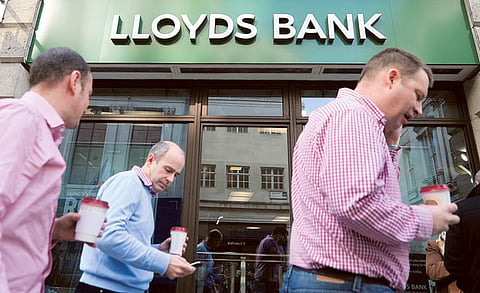Lloyds hit with another charge for mis-sold policies
UK bank takes a 900m pounds hit this time and taking total to £11.3b

London: British bank Lloyds has taken another £900 million (Dh5.3 billion, $1.5 billion) charge to compensate customers mis-sold loan insurance, delivering a further blow to the lender which only narrowly passed European health checks on the sector’s finances.
The new charge took the bank’s total cost to cover the mis-selling of payment protection insurance (PPI) to £11.3 billion, more than any other bank and close to half of the total bill for the industry. The policies were meant to cover repayments if customers fell ill or lost their jobs but were often sold to people who did not need them or would be ineligible to claim.
Analysts at Citi said they expected Lloyds Banking Group Plc to set aside another £1 billion for PPI compensation next year and Lloyds Finance Director George Culmer said he could not rule out further increases. Culmer said complaints about PPI had risen by “about 2 or 3 per cent” in the third quarter from the previous three months, although he said they were still down 18 per cent on the year.
Lloyds said that, if it were to see a similar level of complaints in the fourth quarter as in the third, the required provision would increase again by £600 million. However, Culmer said complaints had fallen by about 8 per cent in the first three weeks of October.
“It’s certainly reassuring to see that it’s started to fall again,” he said.
The new mis-selling charge comes two days after the bank, 25 per cent-owned by the British government, only narrowly passed a test set by regulators to assess whether banks have enough capital to weather another economic crash. Lloyds, which was the worst performing British bank in the European stress tests, faces a further test by the Bank of England (BoE) in December which will measure its resilience against scenarios including a 35 per cent decline in house prices and a rise in interest rates to 6 per cent.
The result of that test will be key to whether the bank is cleared by Britain’s financial regulator to pay its first dividend since it was rescued by a £20.5 billion government bailout during the financial crisis of 2007-09. “Whilst we do not see failure as having capital-raising implications, we no longer expect Lloyds to pay a 2014 dividend,” said Macquarie analyst Ed Firth.
Culmer said he expected Lloyds to pass the BoE stress test and remained confident the bank would be cleared to pay a “modest” dividend for 2014. “The discussions look at earnings, they look at capital and they look at stress tests. We consider ourselves to be in a good position with regards those three criteria as we go into those discussions,” Culmer said.
Lloyds also confirmed its previously reported plan to axe 9,000 jobs in the next three years and to close 200 branches, partly offset by the opening of 50 new ones. The net reduction equates to cutting its total branch network by about 6 per cent.
Chief Executive Antonio Horta-Osorio said he expected competitors to shut more branches during the period and for Lloyds to subsequently grow its market share.
As part of a strategic plan for the next three years unveiled alongside third-quarter results, the bank said it would invest £1 billion in digital technology. It plans to lend an additional 30 billion pounds across Britain over that period, aiming to grow in areas where it is under-represented, including consumer lending and financial planning and retirement.
Lloyds reported an underlying profit of £2.2 billion in the quarter, up 41 per cent from a year ago, as losses from bad debts fell sharply. Statutory profit, or pretax profit without one-offs, in the latest quarter was £751 million.
Horta-Osorio warned that tougher capital requirements on UK banks, expected to be announced on Friday, could result in the cost of home loans rising.
The Bank of England is expected to impose a “leverage ratio” of between 4 and 5 per cent, higher than the 3 per cent it currently applies. That means a bank would have to hold between 4 and 5 pounds for each 100 pounds it lends.
Sign up for the Daily Briefing
Get the latest news and updates straight to your inbox



